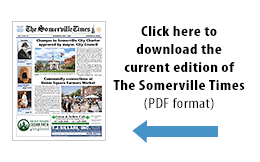Somerville’s air is hazardous to your health
First in a three-part series
In 1971, officials in Governor John Volpe’s administration ignored evidence that I-93 would generate as much as ten times the federally-allowable limits on regulated air pollutants. Their rationalization was that improved engine technology would, in the following years, reduce the production of these pollutants—carbon monoxide, lead, and particulates.
They were right. And they were wrong.
Deadly Impacts
In the next three decades, auto manufacturers did significantly improve the efficiency of petroleum engines and the effectiveness of catalytic converters, but Eastern Massachusetts’ highway trips increased by 40% per decade. Morning commuters heading into Boston pass by Somerville at an average of 11 miles per hour, producing four times the pollution of a car traveling at 65 mph.
More importantly, we now know that auto exhaust’s deadliest effects are not caused by regional air pollutants, but by fine particles that are less than 2.5 microns—one ten-thousandth of an inch. They are largely combustion products, as well as ground up concrete, tires, and metals. When they first leave the exhaust pipe, they are two ten-millionths of an inch thick. Within 100 meters (325 feet) of a roadway, there are up to 1.6 million of them in a cubic inch of air.
Pollutants like carbon dioxide spread over long distances and time periods. Fine and ultrafine particles don’t travel that far. Their impact is deadlier and much more local. This is why Somerville has the highest number of excess deaths per square mile from heart attacks and lung cancer among Massachusetts’ 351 cities and towns, while next-door Cambridge has no excess deaths.
Between 1996 and 2000, Somerville had 145 such excess deaths, even though we smoked less than average. The 14 Eastern Massachusetts cities and towns that had the highest excess deaths per square mile are shown in the bar graph. They represent 10% of the area’s land and 25% of its population, but account for 75% of its excess heart/lung deaths.
The map, in which these jurisdictions are marked with corresponding bar-chart colors, suggests why their health burden is so great. They are closest to the roadways and facilities in which vehicles produce the most pollution. In Somerville, this is I-93, Routes 28, 38, and 99, and 200 diesel train trips per week.
Boston does not show up on this list because most of its residents are a sufficient distance from major vehicular pollution sources. But East Boston, South Boston, and Charlestown are the neighborhoods closest major highways and Logan Airport. Their lung cancer rates from 1997 to 2001 were 35-to-50% higher than state averages.
Think about the highest-volume and most-congested highways that you know. Those communities are where you will find excess deaths.
Inescapable Evidence
Scientists have published over 2,000 research papers on fine particles. The evidence is inescapable that their effects are lethal and localized. Here is how that evidence developed.
The 1970 creation of the Environmental Protection Agency (EPA) stimulated a great deal of research. By the early 1990s, scientists understood that many of pollution’s worst health impacts could not be explained by the effects of the “criteria pollutants” regulated by the EPA.
In 1993, Harvard School of Public Health researchers published a study begun in 1974, comparing air quality to public health in six cities. It found that people living in areas with the most fine particles in the air died, on average, two years earlier than the rest of the U.S. These results were so astounding that the researchers themselves were skeptical and encouraged others to test them.
The American Cancer Society had a database containing 16-year health histories for 1.2 million people. A 1995 analysis of these records confirmed the six-city results and produced a surprise—fine particles were associated with heart attacks even more than lung cancer.
EPA revised its particulate standards in 1997. The trucking industry attacked these two studies and sued the EPA. The independent Health Effects Institute, funded half by industry and half by government, retained a completely separate set of experts, redid the studies, and found the same results. The EPA is now using a 2002 analysis of the Cancer Society data to formulate new guidelines.
Over this same period, similar results came in from Europe. A 2003 Norwegian study followed up on 16,200 men, first studied 27 years earlier. It found a strong correlation between vehicular air pollution and lung cancer. A 2003 study from the Netherlands looked at people living within 100 meters (325 feet) of a highway. They died from cardiopulmonary diseases at a rate 95% higher than their countrymen.
Forces for Change
Over the last four years, private citizens from Somerville attended over 75 meetings of the Boston Metropolitan Planning Organization, the body that decides on Eastern Massachusetts’ highway and transit investments. They presented the scientific evidence discussed above and advocated for Orange and Green Line investments.
Commonwealth officials listened. This Spring, they made an enormous policy change, committing $560 million to extending the Green Line. The extension will make a significant reduction in the lethal pollutants that we breathe. Sadly, this reduction is only a fraction of the increase in pollution that the city’s plans for Assembly Square will create.















Reader Comments